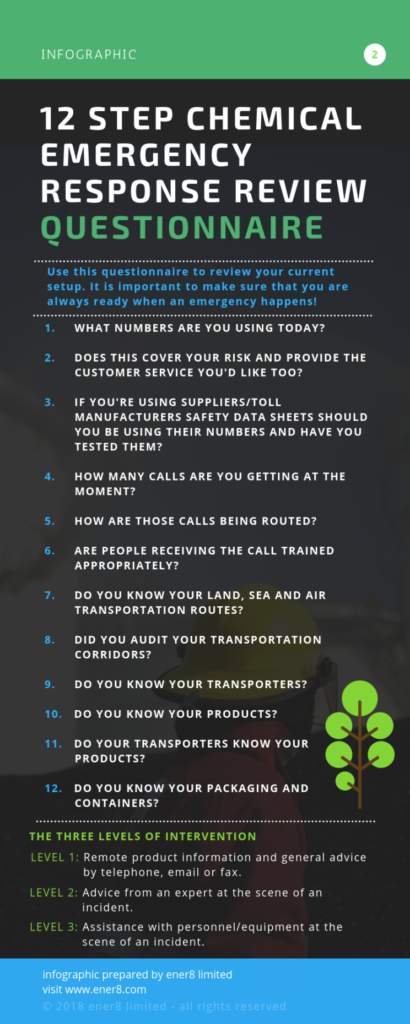12 Questions To Review Your Chemical Emergency Response
Companies involved in the chemical and hazardous goods supply chain have to put in place a chemical emergency response plan. Since many organizations do not know where to commence, we have written this article to provide a starting point for a critical review. Use the questions in below Infographic and let us know if you need help!
Incidents can have a huge impact on the brand and reputation of a company, increase costs, result in a risk to health and life, and affect business continuity. It may also be a regulatory obligation. It is important to be prepared, such as having in place a valid emergency telephone number and understanding transportation corridors.
When an incident or spillage occurs, the actions of those picking up the phone or at the scene can help mitigate the impact. Accurate and calm advice on the correct preventative measures can make sure that those involved make the right decisions.
A 24-hour level 1 chemical emergency response helpline is the first line of protection for people, the environment, assets, and commercial reputation (PEAR). Level 1 response covers remote product information and general advice by telephone.
Level 1 support, but what do you do then?
Often during an incident, the emergency services require a company representative at the scene to provide advice. According to The European Chemical Safety Council or Cefic, for about 10% of distribution incidents, a company expert is called to the site.
Large manufacturers may have more resources available and could be in a position to send their experts to an incident site if required. However, these resources are not always available, especially if a global cover is required.
That is why many businesses, including large manufacturers and logistics companies, rely on the expertise of Level 2 and level 3 emergency response support companies.
Level 2: advice from an expert at the scene of an incident.
Level 2 advice is given by an expert at the site and is often similar to that provided by level 1 emergency responders. The main difference is the benefit of being able to be at the incident to see and evaluate the exact circumstances.
Level 2 advice is often required for more serious incidents and is provided by responders that have experience in managing incidents and working with the emergency services.
As described by CEFIC, this is advice following professional assessment on the scene of the incident, when requested by the Authorities. This level of response involves providing advice after having assessed the incident, possibly using personal protective equipment, and representing the company’s interest vis-à-vis the authorities and public.
Level 3: assistance with personnel/equipment at the scene of an incident.
Level 3 consists of post-incident clean-up, which can be as simple as product recovery and disposal, or be more comprehensive and consist of land decontamination. Large spills will probably require a level 3 response.
This involves deploying an experienced crew and equipment to the incident site depending on the product characteristics and technical complexity. Assistance with equipment and personnel on the scene of the incident is, therefore, most of the time outsourced to expert companies.
Infographic: 12 chemical emergency response review questions
Make sure you get it right by reviewing the 12 questions in the below infographic.

Conclusion
Being able to deal with emergencies is a top priority for companies handling hazardous goods. These 12 questions will help you to start a critical review of your current setup.
Do you need help reviewing your emergency response setup, or do you want to arrange a transportation corridor audit? Also, what are the main reasons you would require a response? Let me know.
You may also like our article – Emergency Response For The Bulk Logistics & Transport Sector
Photo Credit: Canva

